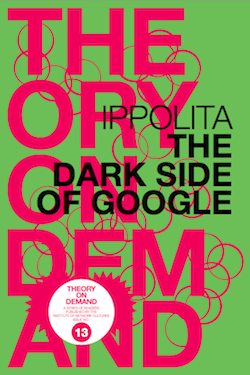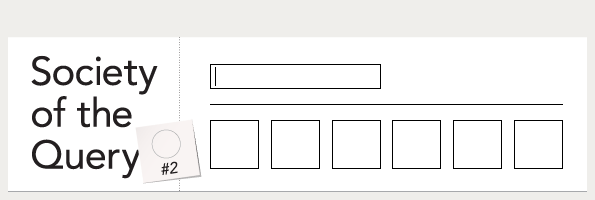 The Dark Side of Google by Ippolita was published as #13 in the INC series Theory on Demand, October 2013. Read the book online, download the PDF, or order your copy through print-on-demand.
The Dark Side of Google by Ippolita was published as #13 in the INC series Theory on Demand, October 2013. Read the book online, download the PDF, or order your copy through print-on-demand.
In The Dark Side of Google Italian writers’ collective Ippolita provides a thorough, fresh analysis of what is behind the universe of Google and the metadata industry. In recent years Google has established itself as a major point of Internet access. We have progressively adapted to its sober, reassuring interface and its advertisements (discretely off to the side, yet always present). We have adopted its services and the habit of using it to the degree that ‘googling’ has become a form of behavior: ‘If you don’t know what it is, Google it!’
Google shows mastery in taking advantage of our need for simplicity. We sit in front of a colossus, an incredibly pervasive system of managing knowledge, comprising aggressive marketing and shrewd management of its own image, and the propagation of highly configurable interfaces that are still implacably recognizable. What is more, Google co-opts methods for developing Free Software, the use of futuristic systems for gathering and storing data. What lies behind the most consulted search engine in the world?
First published in Italian, 2007.
English edition revised and updated, August 2013.
The Dark Side of Google will be presented at the international conference Society of the Query #2, 7-8 November 2013 in Amsterdam. Join us!
Frederiek Pennink worked on editing the manuscript and wrote a summary of the first chapter, which can be read below:
On searches and engines
Since most people nowadays equate the Internet with the Web, search engines are also thought of solely in the context of the Web. The history of search, however, is far older than the history of the Web. Before the Web came into being, search engines had already been in existence for many years as indexation and retrieval services for the information available on the Internet. It wasn’t until many years later, in 1994, when the first web search engine Webcrawler came into operation. As innovative as this engine was at the time; it was only able to return simple lists of web addresses with the headline title of the page as search results. It took another year before a search engine was able to actually rank pages based on their importance; a mechanism that has laid the groundwork for Google’s success today. Not only was this engine called Excite innovative in its efficiency, but it also was the first engine that was geared towards commercial activity. In less than two years Excite became one of the most popular Web portals. However, after a couple of years they decided to drop their original business model and it was then (around 1995) that AltaVista took over as most popular search portal. By the time of AltaVista’s collapse in 1997 it served 25 million queries a day and received 50 million dollars a year as sponsor funding. This illustrates how big of a business ‘search’ had become.
The Birth of Google. Once upon a time there was a garage, then came the University
Larry Page and Sergei Brin, the founders of Google, met at Stanford University. They were both fascinated by the fast growth of the Web and decided to set up the so called ‘Backrub’ project to detect and map the back-links on a given webpage. This project got its own website in 1995 and it was then that they renamed it to Google. The most fundamental innovation Google introduced was the algorithm PageRank that categorizes websites based on the value and amount of in-and outgoing links, similar to how scholars rank academic papers. This algorithm proved to be far more efficient in returning relevant results than other algorithms up until that point had been. In the world of Google search results were no longer fixed, but varied dynamically in accordance with the page’s position within the Web as a whole. Google became an instant hit amongst their peers and senior researches and quickly gained an extraordinary popularity.
Google.com or how ads (discreetly entered the pages)
Around 1998 when Google received 10.000 queries a day, the in-house array of servers was on the verge of collapse and they needed funding quickly. The story has it that Andy Bechtolsheim, one of the founders of Sun Microsystems, became Google’s first investor. This meant that Google as a commercial enterprise was born and in September 1998 they formally opened their offices. Around that time many other search portals popped up (Dot Com Bubble), but thanks to its pure and simple interface without distracting ads and other services, Google managed to maintain its popularity. However, Google could not survive on Bechtolsheim’s money solely, and so Brin and Page too had to look for avenues to commercialize their mass of indexed data. The business model that appeared to be most compatible was one of direct advertisement integrated within the search engine itself and that worked by way of what we now call CPT – Cost Per Thousand impressions. This business model resulted in the appearing of ‘sponsored results’ at the top of the page with search results.
Self Service Ads, or Beyond the Dot Com Crash
The CPT business model, however, did not ensure long time viability, since the sponsored ads and banners were often out of context and thus did not generate many clicks. Google had to look elsewhere, and so they found a solution in the innovative company Goto which based its business model on Cost Per Click (CPC). Goto, however, refused to sell their model and therefore Google had to develop a similar system themselves. Eventually in October 1999 AdWords was given birth to. AdWords was one of the reasons that Google survived the Dot Com bust and in the middle of the year 2000 it was answering 19 million queries a day. Only six months later queries reached the 60 million mark.
Style, Form, and Services Overflow
The year of 2000 was also the year in which the time was ripe for a new round of innovations. In 2001 they launched Google Images, which in a few weeks became one of the Web’s biggest image banks. In 2005 they launched Gmail, and a year later there were Google Scholar and Google Books. New services followed each other in quick succession and by the end of 2006 Google offered a total of 17 different types of services. Not all services were received with enthusiasm though. With Gmail Google was blamed of obtaining crucial information on individual networks of friends and acquaintances, thereby becoming the archetype of an intrusive feature geared towards ‘data-mining’. Similarly, Google Books was met with fierce opposition by a large part of the US Publishers that are member of AAP (American Association of Publishers). Albeit for different reasons (profit rather than privacy), they too weren’t pleased with Google’s mission of universally making accessible world’s information. This distrust towards Google was arguably further stimulated by the introduction of AdSense in 2004. With AdSense Google showed a remarkable ability to milk the relational economy by using the commercial data it indexes. AdSense gives advertisers the ability to choose in detail the profile of prospective viewers, making it a highly appealing tool for those want to sell a brand. The question thus became with what intentions Google hordes all the ‘world’s information’ – are their services not merely a means for advertisers to extract profit from? And at what costs do their free services come? In the end it could well be argued that making information universally accessible through proprietary formats merely means Google is shifting the monopoly on information from a handful of publishers to themselves. The prospect of such a powerful monopoly is dangerous, especially when sold under the banner of ‘speed and further development’.
Google, the Good Giant, goes IPO
“Don’t be evil” or you can provide anything you want provided you’re not naughty – this is the motto of Google’s “capitalism with a human face”. However, cracks are already showing up in this ‘being Good’ PR: lawsuits galore, suggestions fraud, censored sites etc. With net profits close to US$ 185 million in 2002, it was hardly surprising to see that investors were starting to demand more transparency, control and a more credible business profile. This is why eventually Eric Schmidt – a manager with a proven development track record – was appointed CEO by Page and Brin. Ironically, after Page’s announcement that Google had no intention of becoming your ‘run-of-the-mill’ company, it was looking to become exactly that. Especially when it was also announced after the introduction of AdSense in 2004, that Google would proceed with the IPO. This proved to be a successful decision, however, since Google is now a giant amongst the giants on the world’s stock market.
Google Inc. or the Monopoly on Search
With a growth that multiplied by 4000 in the course of a mere 5 years, Google has become the closest direct competitor to Microsoft and Yahoo! That is not only in terms of stock market capitalization, but more importantly in terms of popularity and hence of cultural domination of the consumer’s mind. Does this mean that there is nothing that can possibly stand in the way of the growth of such a Giant? Not necessarily; throughout the years there have been several “swamps” Google has gotten bogged down in. They have mostly been complaints that Google manipulates the search results and that their algorithms don’t work as objectively as Google itself suggests. This introduces one of the main problems for when the world would turn into a digital library: who decides what legitimate censorship is? Or more specifically speaking: who is in charge of the instrument that shall maintain the index of such a library? By now it should be clear what Google’s vision on this question is. As technological convergence is coming nearer every day, Google is forcing itself upon us as the one and only access point, management and mediation of digital data. This vision is both fascinating and dangerous, like all historic power struggles have been. The stage of today’s struggle is the Web and the competition is framed by the question of who will establish the new standard of communication. In the last couple of years the keyword associated with this new standard has been the oxymoron “mass personalization”. It represents a paradigm shift – away from mass production consumerism towards a personalized one, sold to us as “freedom of choice”. So how can we respond to such a shift? We can make different choices by looking for other ways of putting our personal information on the Internet and we also have to learn how to link this information in a different fashion (other than Google’s algorithms that is). This will allow for the creation of more innovative and interesting trajectories for each one of us.
What we can conclude on the history of search engines, and therefore the history of Google, is that Google has learned at its own costs (and at those of its users) that innocence does not really belong to this world. They advocate neutrality, but from neutral nations like Switzerland we have learned that they are traditionally militarized to the core. In this history of search engines and the war that raged between them, then, it has become clear what “weapons” Google has been using to achieve the status of a world class “neutral” phenomenon.


